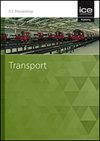考虑结构刚度和阻尼变化的平板轨道运行可靠性混合评估方法
IF 1.2
4区 工程技术
Q4 ENGINEERING, CIVIL
Proceedings of the Institution of Civil Engineers-Transport
Pub Date : 2023-11-16
DOI:10.1680/jtran.21.00087
引用次数: 0
摘要
高速铁路板条轨道结构动力特性的变化对列车的运行质量和安全性有很大的影响。然而,在现有的轨道结构运行可靠性评估规则中,轮轨系统的动态响应关系到运行安全,很少被考虑。针对板条轨道可靠性评估中考虑运行安全性的问题,提出了一种基于脱轨系数和车轮卸荷率定义可用性极限状态(SLS)的混合方法。在可靠性指标计算中,采用响应面法(RSM)和一阶可靠度法(FORM)求解了SLS方程中轮轨力的隐式表达式。为了减少轮轨力计算的计算量,提出了一种基于支持向量回归(SVR)的轮轨相互作用非线性映射代理模型。从计算效率和精度两方面,对比蒙特卡罗模拟(MCS)方法和基于BP神经网络的方法,验证了混合方法的性能。结果表明,混合方法的计算时间仅为BP神经网络方法的1/8.4,而可靠性指标对脱轨系数和车轮卸载率的准确率分别达到98%和97%。最后,应用混合方法对典型板式轨道结构在扣件、水泥沥青砂浆和基础刚度和阻尼系数变化情况下的可靠性进行了评估。结果表明:与CA砂浆和基础相比,紧固件的刚度和阻尼对轮轨动力学和轨道可靠性的影响更大;该研究为高铁板条轨道可靠性评估与列车运行安全提供了新的思路。本文章由计算机程序翻译,如有差异,请以英文原文为准。
A hybrid method for service reliability assessment of slab track subject to change of structural stiffness and damping
The change of the dynamic properties of high-speed rail (HSR) slab track structure can have a great impact on the ride quality and safety of the trains. However, the dynamic response of the wheel-rail system, which is related to operational safety has rarely been considered in the existing rules of service reliability assessment for track structure. To consider the operational safety in reliability assessment for slab track, this paper proposes a hybrid method, in which the serviceability limit state (SLS) is first defined with respect to the derailment coefficient and wheel unloading rate. In reliability index calculation, the response surface method (RSM) and the first-order reliability method (FORM) are employed to solve the implicit expression of wheel-rail force in the SLS equation. To reduce the computation cost in calculating the wheel-rail force, a surrogate model expressing the nonlinear mapping of the wheel-rail interaction based on support vector regression (SVR) is proposed. The performance of the hybrid method is then verified against the Monte Carlo simulation (MCS) method and the BP neural network-based method from the perspective of computation efficiency and accuracy. It is found that the computation time of the hybrid method is reduced to only 1/8.4 of the BP neural network method, while the accuracy of the reliability index can achieve 98% for derailment coefficient and 97% for wheel unloading rate. Lastly, the hybrid method is applied to assess the reliability of a typical slab track structure under the changing stiffness and damping coefficients of the fasteners, cement asphalt (CA) mortar, and foundation. The results show that the stiffness and damping of fasteners have a larger impact on both wheel-rail dynamics and track reliability, compared to those of CA mortar and foundation. This research can provide new insights into the reliability assessment for HSR slab track with respect to the operational safety of the trains.
求助全文
通过发布文献求助,成功后即可免费获取论文全文。
去求助
来源期刊
CiteScore
2.60
自引率
0.00%
发文量
42
审稿时长
5 months
期刊介绍:
Transport is essential reading for those needing information on civil engineering developments across all areas of transport. This journal covers all aspects of planning, design, construction, maintenance and project management for the movement of goods and people.
Specific topics covered include: transport planning and policy, construction of infrastructure projects, traffic management, airports and highway pavement maintenance and performance and the economic and environmental aspects of urban and inter-urban transportation systems.

 求助内容:
求助内容: 应助结果提醒方式:
应助结果提醒方式:


